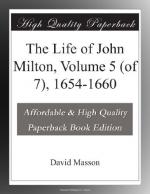taste, and that, contrary to what might have been expected
from his former relations to Scottish Presbyterianism,
his aim now was to rebuild a good and solid Established
Church in Scotland mainly on the native Presbyterian
principle, though under control, and to leave extravagant
spirits, including even those too forward for Independency
among the Scots, to the mere benefits of an outside
toleration. It was not his way to proceed hurriedly,
however; and, as the Protesters were religiously the
men most to his liking, and must by all means be kept
within the Kirk, an agreement between them and the
Resolutioners was a political necessity. To this
end he had again, more than once recently, requested
some of the leaders of both parties to come to London
for consultation, as Gillespie, Livingston, and Menzies,
for the Protesters, had done before. Appeals to
the Civil Power in ecclesiastical matters being against
the Presbyterian theory which the parties professed
in common, that suggestion had not been taken, notwithstanding
the precedent, and the parties had persisted in their
war of mutual invective in Scotland, each getting
what it could by private dealings with the Council
there,—the Resolutioners through Broghill
and the Protesters through Monk. But that could
not last for ever; and, in August 1656, strict Presbyterian
theory had been so far waived by both parties that
both had resolved on direct appeal to his Highness
in London. The Resolutioners had the start.
They had picked out as their fittest single emissary
Mr. James Sharp of Crail, then forty-three years of
age, already well acquainted with London by his former
compulsory stay there, and with the advantage now
of intimacy with Broghill. His Instructions,
signed by three of the leading Resolutioners, were
ready on the 23rd of August. They were substantially
that he should clear the Resolutioners with the Protector
from the misrepresentations of the Protesters, paint
the Protesters in return as mainly hot young spirits
and disturbers, and obtain from his Highness a restoration
of Presbyterian use and wont through the whole Kirk,
with preponderance to the Resolutioners, though not
with a General Assembly till times were more quiet.
Per contra, the Protesters had drawn out certain
propositions to be submitted to Cromwell. They
asked for a Commission for the plantation of kirks,
to be appointed by his authority and to consist of
those he might think fit, to administer the revenues
of the Kirk according to the Acts of Assemblies and
the laws of the land prior to 1651, the fatal year
of the “Resolutions.” They asked
also for a Commission of Visitation, one half to be
elected by the Resolutioners and one half by the Protesters,
to have the power of “planting and purging”
in parishes and of composing differences in Synods
and Presbyteries. For urging these propositions
a deputation to Cromwell had been thought of, and
actually appointed. As it was postponed, however,
Sharp was to be in London first by himself. Hence
some importance for the Protesters in any counterweight
there might be in Argyle’s presence there already.
[1]




